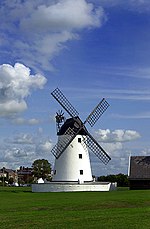Lytham Lifeboat Station
Grade II listed buildings in LancashireGrade II listed lifeboat stations in EnglandLifeboat stations in LancashireLytham St AnnesUse British English from May 2024

Lytham Lifeboat Station is a 'former' lifeboat station, (by virtue of its merger), located in the Fylde coast town of Lytham, Lancashire. A lifeboat was first stationed here by the Shipwrecked Fishermen and Mariners' Royal Benevolent Society (SFMRBS) in 1851. Management of the station was passed to the Royal National Lifeboat Institution (RNLI) on 7 December 1854. In 1931, the Lytham station merged with the St Annes RNLI branch, becoming Lytham St Annes Lifeboat Station
Excerpt from the Wikipedia article Lytham Lifeboat Station (License: CC BY-SA 3.0, Authors, Images).Lytham Lifeboat Station
East Beach, Borough of Fylde
Geographical coordinates (GPS) Address Website Nearby Places Show on map
Geographical coordinates (GPS)
| Latitude | Longitude |
|---|---|
| N 53.735527777778 ° | E -2.9554166666667 ° |
Address
Old Lifeboat House
East Beach
FY8 5EY Borough of Fylde
England, United Kingdom
Open on Google Maps








